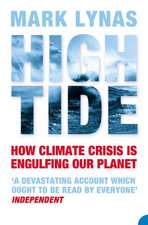Contaminated Sediments: The Handbook of Environmental Chemistry, cartea 5 / 5T
Editat de Tarek A. Kassim, Damià Barcelóen Limba Engleză Hardback – 12 feb 2009
| Toate formatele și edițiile | Preț | Express |
|---|---|---|
| Paperback (1) | 777.11 lei 38-44 zile | |
| Springer Berlin, Heidelberg – 19 noi 2010 | 777.11 lei 38-44 zile | |
| Hardback (1) | 790.70 lei 38-44 zile | |
| Springer Berlin, Heidelberg – 12 feb 2009 | 790.70 lei 38-44 zile |
Din seria The Handbook of Environmental Chemistry
- 18%
 Preț: 1819.46 lei
Preț: 1819.46 lei - 18%
 Preț: 1827.32 lei
Preț: 1827.32 lei - 18%
 Preț: 2102.76 lei
Preț: 2102.76 lei - 18%
 Preț: 2089.35 lei
Preț: 2089.35 lei - 18%
 Preț: 2481.57 lei
Preț: 2481.57 lei - 18%
 Preț: 1223.43 lei
Preț: 1223.43 lei - 5%
 Preț: 1419.56 lei
Preț: 1419.56 lei - 15%
 Preț: 639.41 lei
Preț: 639.41 lei -
 Preț: 392.97 lei
Preț: 392.97 lei - 5%
 Preț: 366.56 lei
Preț: 366.56 lei - 18%
 Preț: 1826.69 lei
Preț: 1826.69 lei - 15%
 Preț: 640.71 lei
Preț: 640.71 lei - 18%
 Preț: 728.91 lei
Preț: 728.91 lei - 5%
 Preț: 1424.89 lei
Preț: 1424.89 lei - 18%
 Preț: 1225.94 lei
Preț: 1225.94 lei -
 Preț: 386.00 lei
Preț: 386.00 lei - 18%
 Preț: 732.70 lei
Preț: 732.70 lei - 15%
 Preț: 641.53 lei
Preț: 641.53 lei - 5%
 Preț: 1416.81 lei
Preț: 1416.81 lei - 15%
 Preț: 644.82 lei
Preț: 644.82 lei - 5%
 Preț: 1421.76 lei
Preț: 1421.76 lei -
 Preț: 386.39 lei
Preț: 386.39 lei -
 Preț: 389.49 lei
Preț: 389.49 lei - 5%
 Preț: 719.02 lei
Preț: 719.02 lei - 5%
 Preț: 714.63 lei
Preț: 714.63 lei - 18%
 Preț: 1215.22 lei
Preț: 1215.22 lei -
 Preț: 392.97 lei
Preț: 392.97 lei - 18%
 Preț: 1832.08 lei
Preț: 1832.08 lei - 15%
 Preț: 639.73 lei
Preț: 639.73 lei - 5%
 Preț: 1925.56 lei
Preț: 1925.56 lei -
 Preț: 381.98 lei
Preț: 381.98 lei - 5%
 Preț: 363.97 lei
Preț: 363.97 lei -
 Preț: 386.00 lei
Preț: 386.00 lei - 5%
 Preț: 1423.39 lei
Preț: 1423.39 lei - 15%
 Preț: 643.16 lei
Preț: 643.16 lei -
 Preț: 383.12 lei
Preț: 383.12 lei - 15%
 Preț: 642.51 lei
Preț: 642.51 lei - 5%
 Preț: 716.09 lei
Preț: 716.09 lei - 5%
 Preț: 1407.87 lei
Preț: 1407.87 lei - 18%
 Preț: 1231.01 lei
Preț: 1231.01 lei
Preț: 790.70 lei
Preț vechi: 1040.40 lei
-24% Nou
Puncte Express: 1186
Preț estimativ în valută:
151.30€ • 157.97$ • 125.22£
151.30€ • 157.97$ • 125.22£
Carte tipărită la comandă
Livrare economică 01-07 aprilie
Preluare comenzi: 021 569.72.76
Specificații
ISBN-13: 9783540880134
ISBN-10: 3540880135
Pagini: 200
Ilustrații: XVI, 181 p. 36 illus., 2 illus. in color.
Dimensiuni: 155 x 235 x 17 mm
Greutate: 0.52 kg
Ediția:2009
Editura: Springer Berlin, Heidelberg
Colecția Springer
Seriile The Handbook of Environmental Chemistry, Water Pollution
Locul publicării:Berlin, Heidelberg, Germany
ISBN-10: 3540880135
Pagini: 200
Ilustrații: XVI, 181 p. 36 illus., 2 illus. in color.
Dimensiuni: 155 x 235 x 17 mm
Greutate: 0.52 kg
Ediția:2009
Editura: Springer Berlin, Heidelberg
Colecția Springer
Seriile The Handbook of Environmental Chemistry, Water Pollution
Locul publicării:Berlin, Heidelberg, Germany
Public țintă
ResearchCuprins
The Influence of Contaminated Sediments on Sustainable Use of the Planet.- Chlorinated and Brominated Organic Pollutants in Contaminated River Sediments.- Effects of Static vs. Tidal Hydraulic Conditions on Biogeochemical Processes in Mesocosms: Degradation of Aromatic Hydrocarbons (AHs).- Marine Sediment Toxicity Identification Evaluations (TIEs): History, Principles, Methods, and Future Research.- Nucleic Acid-Based Techniques for Studying Diversity and Activity of Bacterial Communities in Oil-Contaminated Sediments.- Steady-State Model of Chemical Migration in a Sediment Cap.
Textul de pe ultima copertă
When discussing the issue of contamination of the aquatic environment, water pollution is still the major aspect that has been regulated and extensively studied, but poor attention has been devoted to sediments. Sediments have been described as the sink or storage place and a source for contaminants entering river systems through various pathways. But bottom sediments have various functions in the environment, such as providing habitat for many aquatic organisms, and are an important component of aquatic ecosystems.
This volume of the Handbook deals with various aspects of sediment contamination such as the fate and behavior of persistent organic pollutants, the application of sediment toxicity identification evaluation (TIE) protocols, and the various ways to degrade toxic pollutants from sediments. Overall the book provides readers the fundamental knowledge needed to better understand the complex issue of contaminated sediments.
This volume of the Handbook deals with various aspects of sediment contamination such as the fate and behavior of persistent organic pollutants, the application of sediment toxicity identification evaluation (TIE) protocols, and the various ways to degrade toxic pollutants from sediments. Overall the book provides readers the fundamental knowledge needed to better understand the complex issue of contaminated sediments.
Caracteristici
Includes supplementary material: sn.pub/extras











